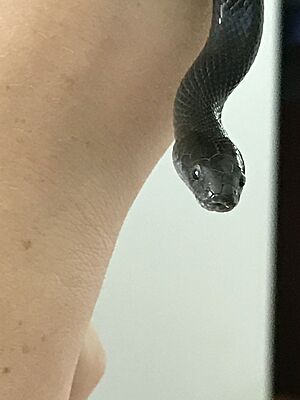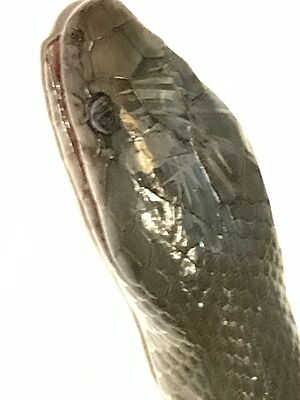Olive house snake facts for kids
Quick facts for kids Olive house snake |
|
|---|---|
 |
|
| Conservation status | |
| Scientific classification | |
| Genus: |
Lycodonomorphus
|
| Species: |
inornatus
|
The Lycodonomorphus inornatus, often called the olive house snake, the black house snake, or the olive ground snake, is a type of snake. It is not venomous, meaning it's not harmful if it bites. This snake belongs to the family called Lamprophiidae. You can only find this snake in southern Africa, making it endemic to that area. It is active at night and lives mostly on the ground.
Contents
About the Olive House Snake
Olive house snakes usually grow to be about 45 to 75 centimeters (about 1.5 to 2.5 feet) long. Some have been recorded to reach up to 130 centimeters (about 4.3 feet)!
These snakes can be different colors. They might be dark olive or black. Some are light brown or even olive-grey-green. Their bellies are usually a bit lighter, especially around their chin, throat, and neck.
Where They Live and What They Like
The olive house snake lives in South Africa and Eswatini. You can find them along the eastern coast, from the southwestern Cape all the way to the Transkei area. They also live in the low-veld regions of KwaZulu-Natal, the Mpumalanga escarpment, and Limpopo Province.
These snakes prefer places with enough moisture. They live in coastal bushveld (a type of woodland), fynbos (a unique plant area), and grassveld (grasslands). Sometimes, they even live close to where people live! There have been reports of them in Namibia, but these have not been officially confirmed.
Life and Habits of the Olive House Snake
The olive house snake is a nocturnal animal, which means it is active at night. It usually hunts on the ground. These snakes are generally slow-moving and calm. However, if they feel threatened or bothered, they might bite.
Reproduction
Female olive house snakes lay eggs. They usually lay between 5 and 15 eggs at a time.
What They Eat
The olive house snake has a varied diet. It hunts and eats lizards, small rodents (like mice), and even other snakes.
Who Eats Them
These snakes can become food for other animals. Different types of raptors, which are birds of prey, hunt them. This includes the snake eagle and the secretary bird. Other snakes also prey on the olive house snake.



